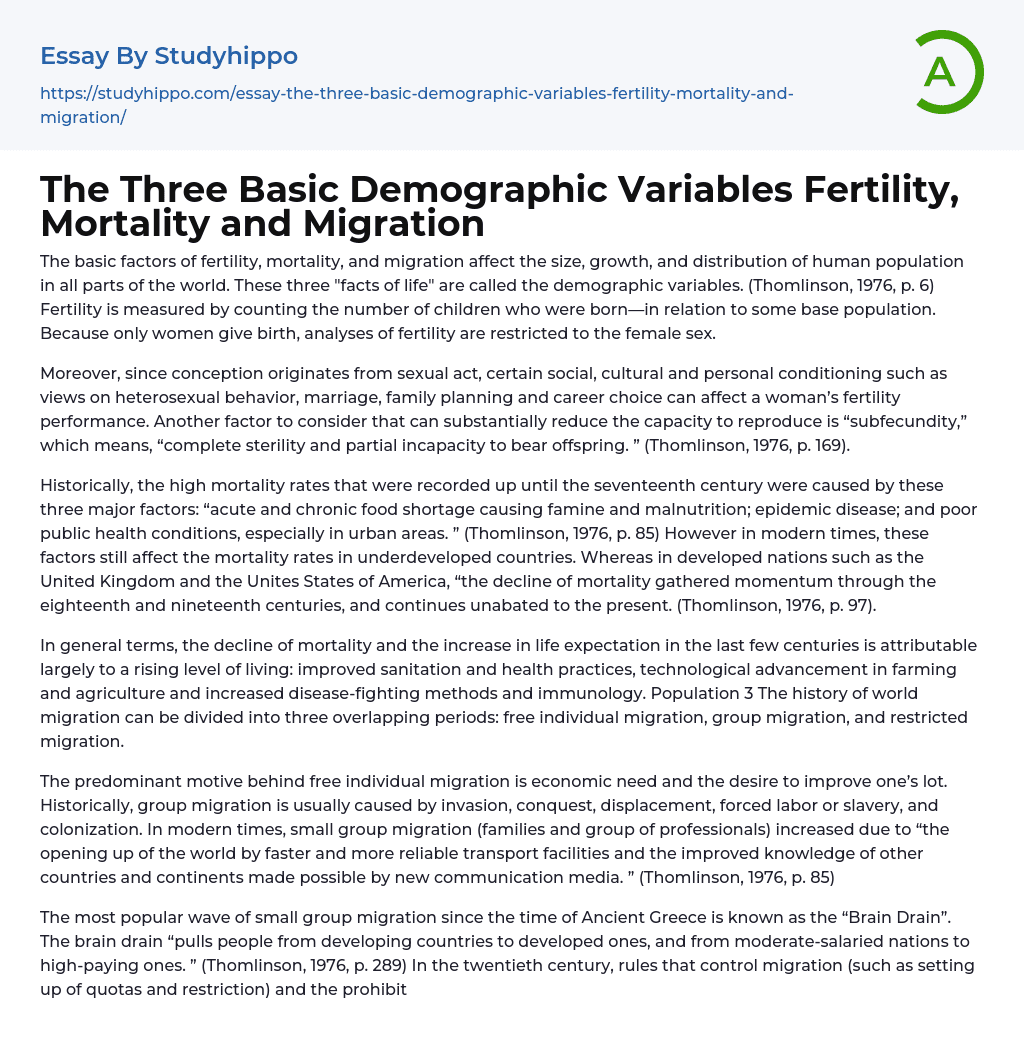

The Three Basic Demographic Variables Fertility, Mortality and Migration Essay Example
The basic factors of fertility, mortality, and migration affect the size, growth, and distribution of human population in all parts of the world. These three "facts of life" are called the demographic variables. (Thomlinson, 1976, p. 6) Fertility is measured by counting the number of children who were born—in relation to some base population. Because only women give birth, analyses of fertility are restricted to the female sex.
Moreover, since conception originates from sexual act, certain social, cultural and personal conditioning such as views on heterosexual behavior, marriage, family planning and career choice can affect a woman’s fertility performance. Another factor to consider that can substantially reduce the capacity to reproduce is “subfecundity,” which means, “complete sterility and partial incapacity to bear offspring. ” (Thomlinson, 1976, p. 169).
Historically, th
...e high mortality rates that were recorded up until the seventeenth century were caused by these three major factors: “acute and chronic food shortage causing famine and malnutrition; epidemic disease; and poor public health conditions, especially in urban areas. ” (Thomlinson, 1976, p. 85) However in modern times, these factors still affect the mortality rates in underdeveloped countries. Whereas in developed nations such as the United Kingdom and the Unites States of America, “the decline of mortality gathered momentum through the eighteenth and nineteenth centuries, and continues unabated to the present. (Thomlinson, 1976, p. 97).
In general terms, the decline of mortality and the increase in life expectation in the last few centuries is attributable largely to a rising level of living: improved sanitation and health practices, technological advancement in farming and agriculture and increased disease-fighting methods and immunology. Population 3
The history of world migration can be divided into three overlapping periods: free individual migration, group migration, and restricted migration.
The predominant motive behind free individual migration is economic need and the desire to improve one’s lot. Historically, group migration is usually caused by invasion, conquest, displacement, forced labor or slavery, and colonization. In modern times, small group migration (families and group of professionals) increased due to “the opening up of the world by faster and more reliable transport facilities and the improved knowledge of other countries and continents made possible by new communication media. ” (Thomlinson, 1976, p. 85)
The most popular wave of small group migration since the time of Ancient Greece is known as the “Brain Drain”. The brain drain “pulls people from developing countries to developed ones, and from moderate-salaried nations to high-paying ones. ” (Thomlinson, 1976, p. 289) In the twentieth century, rules that control migration (such as setting up of quotas and restriction) and the prohibition of all movement of certain types of people (criminals and those suspected to be terrorists and communists), severely curtail migration, particularly in the United States of America.
The most fundamental equation in demography is: Final Population = Initial Population + Births — Deaths + In-migrants — Out-migrants. Due to the ever-changing factors that affect the three demographic variables previously discussed, it is therefore concluded that population analysis and demographic studies “require research methods that permit the calculation of accurate rates of births, deaths, and in- and out-migration. ”
- Cultural Assimilation essays
- Demography essays
- Ethnographic essays
- Population essays
- Population Growth essays
- John Locke essays
- 9/11 essays
- A Good Teacher essays
- A Healthy Diet essays
- A Modest Proposal essays
- A&P essays
- Academic Achievement essays
- Achievement essays
- Achieving goals essays
- Admission essays
- Advantages And Disadvantages Of Internet essays
- Alcoholic drinks essays
- Ammonia essays
- Analytical essays
- Ancient Olympic Games essays
- APA essays
- Arabian Peninsula essays
- Argument essays
- Argumentative essays
- Art essays
- Atlantic Ocean essays
- Auto-ethnography essays
- Autobiography essays
- Ballad essays
- Batman essays
- Binge Eating essays
- Black Power Movement essays
- Blogger essays
- Body Mass Index essays
- Book I Want a Wife essays
- Boycott essays
- Breastfeeding essays
- Bulimia Nervosa essays
- Business essays
- Business Process essays
- Canterbury essays
- Carbonate essays
- Catalina de Erauso essays
- Cause and Effect essays
- Cesar Chavez essays
- Character Analysis essays
- Chemical Compound essays
- Chemical Element essays
- Chemical Substance essays
- Cherokee essays



